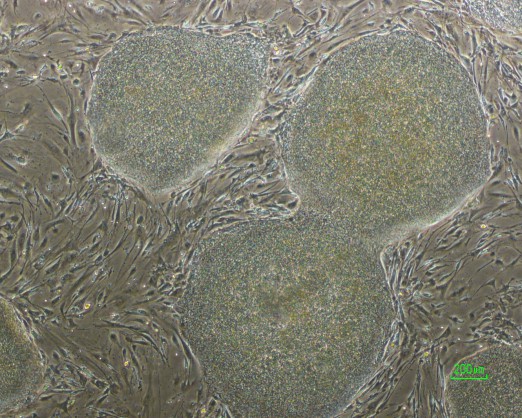Why ?
Stem cells, conventionally defined by their ability for self-renewal and differentiation, are found in all adult tissues. However, they are rare and difficult to access, with the exception of haematopoietic stem cells and mesenchymal stem cells. The only stem cells capable of giving rise to all the tissues of the body are the embryonic stem cells, originally derived in mice in 1981 and in humans in 1998.
The stem cell field has undergone a revolution over the past decade thanks to the work of Shinya Yamanaka on the reprogramming of adult cells into induced pluripotent stem cells (iPS cells)(2006). The feasibility of this concept had been studied by John Gurdon as early as 1960. These two pioneers shared the Nobel Prize in Physiology and Medicine in 2012.

Colonies of human iPS cells in culture. © ESTEAM Paris-Sud
The method of producing induced pluripotent stem cells (iPS) dispenses with the use of embryos. Reprogramming of adult cells to pluripotent stem cells is induced by overexpression of genes acting in synergy: Oct4, Sox2, Klf4 and c-Myc. Other genes, like Nanog and Lin28, are also capable of inducing pluripotency. All adult cells are reprogrammable with varying efficiency. This reprogramming involves the acquisition of two fundamental properties of embryonic stem cells: self-renewal (theoretically unlimited symmetric cell division) and pluripotency (ability to differentiate into all lineages of the organism in the presence of appropriate stimuli).
IPS cells open major prospects with scientific, medical, economic and social in the areas of:
Personalized medicine for monogenic or polygenic genetic diseases.
- Rare Diseases with pathophysiological study and discovery of new therapeutic approaches.
- Cancer with the discovery and development of new drugs targeting cancer stem cells.
- Pharmaco-genomics study: efficacy and drug predictive toxicity dependinf on stem cell genome, and patients epigenome polymorphism.
Regenerative medicine focuses on the study of the potential repairing and organ regeneration through tissue transplantation (cell and gene therapies) or organs built by bioengineering.
INGESTEM is a center of excellence bringing together the scientific and technological expertise to meet all of these challenges.











